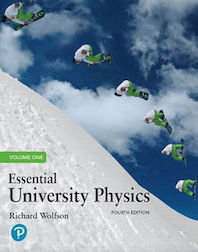PHY146H Principles of Physics I
The first physics course is for students intending to pursue any of the Physics or Astronomy programs and highly recommended for some of the other programs in the Department of Chemical and Physical Sciences. This course provides a rigorous introduction to the concepts, approaches and tools that physicists use to describe the physical world through the study of classical and modern mechanics. Topics include mathematical physics, kinematics and dynamics as well as conservation laws for energy and momentum. Special relativity will be introduced as a topic that successfully addresses problems that arose in classical mechanics.

|
JCP322H Statistical Mechanics
Statistical methods for bridging the quantum behaviour of atoms and molecules to their macroscopic properties in solid, liquid and gaseous states. The course introduces partition functions, canonical ensembles, and their application to thermodynamic properties such as entropy, heat capacity, equilibrium constants, reaction rates, and Bose-Einstein/Fermi-Dirac distribution functions.
PHY2711H Biophysical Techniques
This course will provide a survey of experimental biophysical techniques. We will discuss methods that are used to examine both the structure and function of biophysical systems, from whole organisms down to single molecules. The course is intended both for students intending to work within an experimental setting and to help those with theoretical interests understand how their ideas may be validated. Topics may include confocal and multiphoton imaging, current DNA and RNA sequencing techniques, high throughput methods, super-resolved microscopy, cryo-electron microscopy, nuclear magnetic resonance (NMR), Forster resonance energy transfer (FRET), optical and magnetic tweezers, atomic force microscopy (AFM), fluorescence correlation spectroscopy (FCS), electrophysiology, as well as x-ray and neutron scattering. | |
PHY2707H Cellular and Molecular Biophysics I
This course investigates the physical properties of biomolecules with emphasis on principles of equilibrium and non-equilibrium thermodynamics and statistical mechanics that can be used to describe quantitatively biological structure and function. Through rigorously introduced new concepts and theories, and an extensive use of examples from literature, students will gain an understanding of the general importance and broad applicability of Physical Laws to life sciences. Student participation includes reading and preparing papers assigned for discussion in each lecture. | |
JCP421H Quantum Mechanics
The course offers an in-depth examination of the fundamental principles of quantum theory and a guide to its applications. Topics may vary but will include: time-independent Schrodinger equation, quantum dynamics in Heisenberg and Schrodinger pictures, time-independent perturbation theory, WKB approximation, variational method, spin, addition of angular momentum, time-dependent perturbation theory, scattering.
JCB487Y Advanced Interdisciplinary Research Laboratory
Students will work together as members of a multidisciplinary team toward the completion of an interdisciplinary experimental or theoretical research project. Teams will be comprised of at least three students, with representation from at least three areas of specialization, namely, astronomy, biology, chemistry, earth sciences or physics. The interdisciplinary projects will be based on current trends in research and student teams will work to complete their projects with guidance provided by a team of faculty advisors from the Biology Department and the Department of Chemical and Physical Sciences. In addition to the rigorous development of research skills, the course will also provide students with practical experience in project management and training in effective project management techniques. | |
PHY325H Mathematical and Computational Physics
The theory and applications of mathematical methods for the physical sciences. The topics include: vector calculus, linear algebra applied to coordinate transformations, probability distributions, systems of linear ordinary differential equations and boundary value problems, Fourier analysis and orthogonal functions, Laplace's, Bessel's and the Heat equations in various coordinate systems, and use of Legendre polynomials and Spherical Bessel functions. Computational methods and standard software tools will be used to solve the complex physics problems.
PHY255H Introduction to Biomedical Physics
The course focuses on applying principles from introductory Physics to biomedical phenomena. The goal is to illustrate the application of physical principles in life sciences and how this enhances one's understanding of biology. Topics may vary but they will include: the elasticity of muscles, the flow of blood, the electrical signal propagation in nerve cells, the optical properties of the eye, and the sound generation in vocal cords. In addition, the physical basis of medical techniques such as ultrasound imaging, endoscopy, electrocardiography, magnetic resonance imaging, laser surgery, and radiation therapy will be treated quantitatively.




